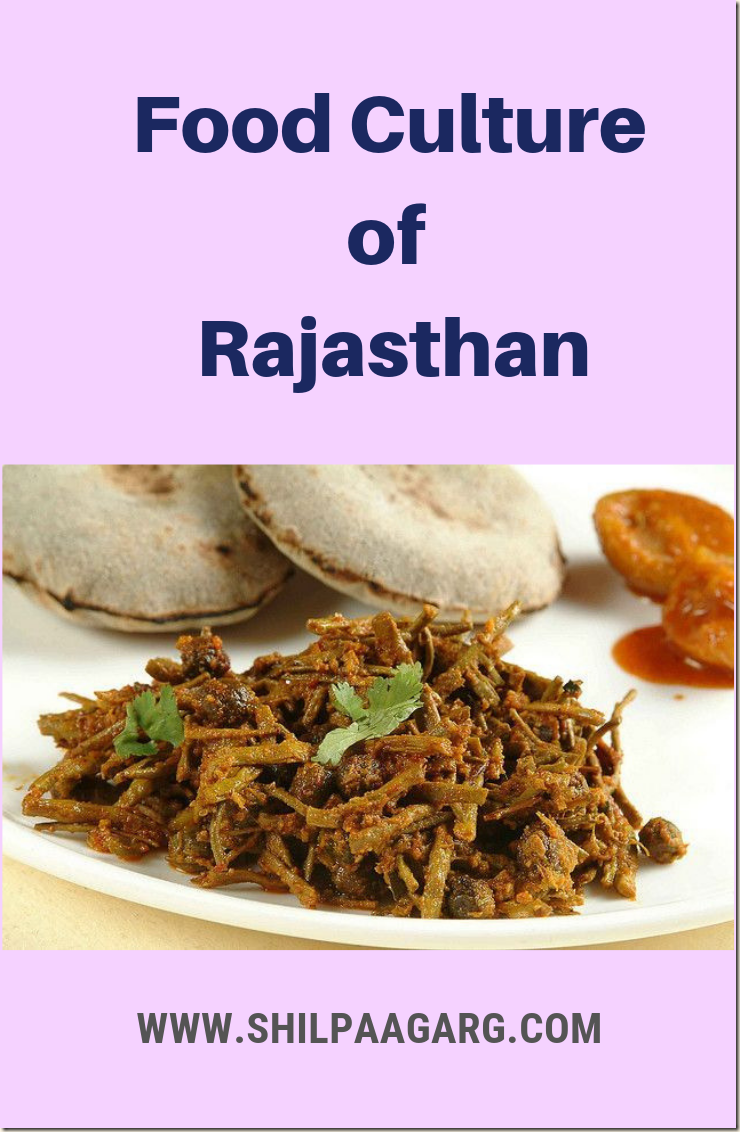You know, the food that we eat everyday tells us about where we come from. We grow up eating the food of the place where we live and that becomes a part of our identity. Different places have different foods and food traditions that define the food culture of the place.
Food culture refers to the practices, attitudes and beliefs of a place regarding food.
Rajasthan has its unique food culture which is defined by the centuries of invasions, wars, climate, religious beliefs and social customs.
Rajasthan, being a desert state, there’s scarcity of vegetables and water. The vegetarian food does not have regular vegetables but dried ingredients cooked in oil and red chillies to preserve the food in high temperatures. Because of the scarcity of water, Rajasthani cuisine is often rich and dairy-based. The non-vegetarian food has hunted animals cooked in some unusual styles.
Let me share some interesting and unique dishes and cooking styles of Rajasthan that forms its food culture.
Papad ki Subzi
Papad in rest of the country is eaten as a snack or meal accompaniment. But in Rajasthan, due to scarcity of vegetables, papad is used as a main dish. Papad is added in a yogurt gravy made with gram flour, chilli powder, turmeric and chopped coriander leaves.
Gatte ki Subzi
This is another dish where you dont need fresh vegetables. Dumplings of gram flour (known as gatte) in a gravy of buttermilk, tomato and spices is an integral part of Rajasthani cuisine.
Ker Sangri
Ker is a wild tangy berry and sangri is long bean grown abundantly in the desert areas of Jaisalmer and Barmer. Legend has it that these were supposedly first used as a food source when famine-struck villagers of Rajasthan had nothing to eat. Today it is a traditional dish that is served in homes, restaurants and at weddings.
Lal Maas
Lal Maas literally means “red meat is a fiery mutton preparation. It is also made with game like rabbit, wild boar and deer. It is said that the king of Mewar wanted a dish that was hot and meaty enough to suit the palate of a warrior. The cooks made the dish but the odour of the hunted deer was still prevalent in the curry even though it had a lot of yogurt and garlic. They added red chillies that not just added to the flavour of the dish but also removed the odour and gave it a bright hue and therefore, the name Laal Maas.
Khad or Pit Cooking
This interesting technique of cooking meat originated in Rajasthan. Meat is prepared in pits, dug out in the sand. This slow-cooking technique was created to ensure that the fire could not be seen by enemy troops.
Dungar Cooking
Another novel cooking technique of Rajasthan is Dungar cooking. When a dish is nearly cooked, it is transferred to a dish with a tight-fitting lid. A live coal in a bowl is placed in the centre and ghee (clarified butter) is poured over it. The lid is tightly closed so that the smoke, trapped for 30 minutes, permeates into the food, giving it an intoxicating smoky flavour and aroma.
Dal baati churma, raab, bajre ki roti with lasun chutney, ghevar, junglee maas are some other dishes that form the rich food culture of Rajasthan.
Have you been to Rajasthan? Do you like Rajasthani cuisine?
My theme for this year’s Blogging from A to Z April Challenge is Food Talks. Join me for some interesting, fun conversations about food experiences, experiments, basics, tips, ideas, hacks, trends and much more.
PC : Source



though I am a non-vegetarian, gatte ki sabzi is my favourite rajasthani cuisine, and laal maas doesn’t appeal to me so much because its too spicy for me 😀
Gatte ki subji and ker sangri ki subji is my favourite. Now I am craving for Gatte ki subji, may be tomorrow’s lunch
Oh I love gatte ki sabzi!!!
How well researched your posts are! I knew the veg ones & have tasted them too. Following your posts Shilpa. Amazing consistency with content, kudos to you. No, hav’nt been to Rajasthan though.
Fabulous food of Rajasthan. So tasty and spicy. I would add salad to any of the meals because there isn’t too much in the way of vegetable but it is sooo delicious.
Very interesting. I have never eaten Khad cooking, Dungar cooking and Lal Maas Rajasthani style. Some day, I must try.
so interesting Shilpa thank you …
My Mom is a Rajasthani, so Gatte ki Subzi and Ker Sangri (when we could procure it in Bombay) made their way to our table often. This post made me nostalgic, Shilpa. Glad you’re introducing readers to Rajasthani cuisine.
Though I am a vegetarian the ker sangria and gatte ki sabzi are my all time favorite. U reminded my visit to Rajasthan.
Ah! Well, what can I say? Except for the laal maas…I AM HUNGRY!!!
Your post felt like the Netflix show, ‘Raja, Rasoi aur anya kahaaniya’. 🙂 All that info on food from a particular state, how it was first made and how it came to be the favoured cuisine of the people of the state…I have eaten daal batti churma, have heard about papad ki sabji and laal maas, but haven’t eaten it. That food image in the pin above made my tummy rumble! 😛
I spent some time in Rajasthan a few years ago and even attended the wedding of the young man who drove me around during my stay, so food featured quite heavily during my visit – and I loved every mouthful. On my travels throughout India, I’ve always enjoyed the food, it is so different from that we enjoy in British Indian restaurants!
My A-Z of Children’s Stories
Your posts always make me hungry. Last I was in Jaipur 2015, and we enjoyed Laal Maas ;P
My top favorites are churma laddu and daal baati.
Love Rajasthani food re! We get our fix from the papad ki subzi and eating at Rajdhani restaurant. I love the dungar method of cooking–the food has such a great flavor. Sigh. Looking forward to visiting Rajasthan soon!
I love Rajasthani food. My aunt is in Jodhpur and thus often take tips from her regarding this. Love gatte ki sabji and ker sangri. Once in a while go for ker Sangri’s kanji too. Thanks for this yummilicious post.
Great post , well written. I must try some dishes.
Wonderful post and now I was craving for Dal Baati and Gatte ki Sabzi. Dungar is what I do to my oven grilled tandoori dishes.
I love this cuisine for its spicy variations starting from raj kachori to lal maans. Gatte ki Sabji yumm and daal bhakri churma is to die for. Lovely yummy post Shilpa.
I love papad and gatte ki sabzi and cook whenever I run out of vegetable ideas.
Oh I love the vegetarian part of Rajasthani cuisine. All those curd based recipes, and churma!
Yummy!
But I have never understand the sev sabji here… bhujia ki sabji???? Seriously now!
Find my F post @ Microwave Eggless Chocolate Cake Recipe | How To Make Eggless Chocolate Cake in Microwave
I love gatte ki sabji and daal baati but never had others you mentioned. Although I have heard of Lal Maas. Didn’t know about Papad ki sabzi. Interesting!
Enlightening post shilpa, I have not tasted Rajasthani food- would love to travel to this place and try out some good food. Thanks for sharing.
I love gatte ki sabzi, lal maas and sangri. Also had daal baati churma at a friend’s place one.
I love Rajasthani food. Except Lal Maas have eaten all the dishes that you mentioned. I don’t eat mutton hence skipped that. And we also bought ker sangri ka achar back with us. Also all the delicious sweet meats and farsan are so tasty. Ghevar and jodhpuri mirchi bhajji! Yum
Visiting Rajasthan is on my wish-list.But hubby cannot hear that. Have tasted ghatte ki sabzi, sangri ker, daal baati (I have twice prepared it) and churma laddoo. Have read about the Rajasthani Rajputs in history.
https://ideasolsi65.blogspot.com/2019/04/feet-parts-of-body.html
I love love loveeeee Rajasthani food. We visited in October and lost our hearts to the food and the people. Dal Baati Churma is way too delicious!